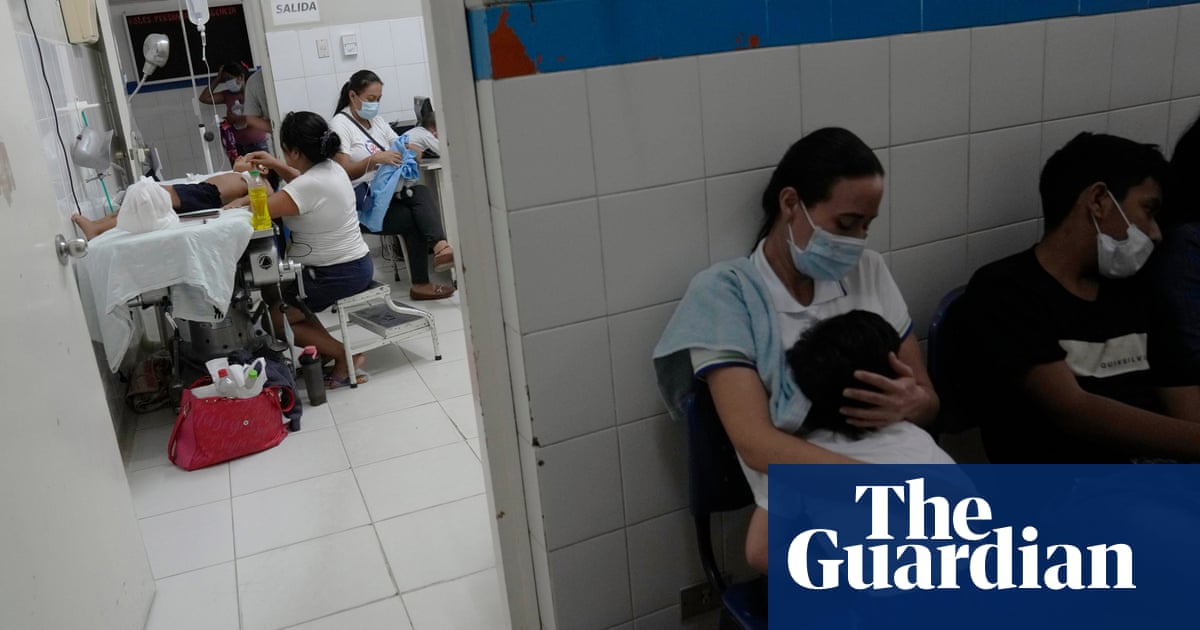
In a stream of white, mourners walked behind an ivory-coloured, shoulder-borne coffin as neighbours, heads bowed and hands clasped, peered out of doorways on the narrow street in Castilla, a middle-class suburb in Piura, northern Peru.
At the gates of the San José de Tarbes school, dozens of girls wearing grey skirts and white shirts with red ties awaited the cortege, holding white balloons and roses. It was a farewell for their schoolmate Priscila Quispe, seven, who died of dengue in the Santa Rosa public hospital last week.
In the school courtyard, her teacher paid tribute to the bright, caring girl as the children, staff and parents stood in stunned silence.
Quispe was one of the victims of a dengue outbreak sweeping through Piura, the centre of Peru’s worst epidemic of the mosquito-borne virus on record. Peru has 137,539 dengue cases and registered at least 223 deaths, the highest mortality rate for the virus in the Americas, according to data released on Saturday from the Panamerican Health Organisation and Peru’s National Center for Epidemiology, Disease Prevention and Control.
Battered by heavy rains and flooding in recent months, Piura has seen more than 40,000 cases and 69 deaths this year, at least a dozen of them children, in the city of around half a million, according to the local health authority.
In April and May, Cyclone Yaku unleashed torrential rain on northern Peru, and the flood waters provided the ideal breeding grounds for Aedes aegypti mosquito, the vector for dengue, as well as chikungunya and zika, which is endemic in the hot northern region, near the border with Ecuador.
“The first day, [my daughter] had a high fever and abdominal pain, then on the second and third day she was vomiting and had diarrhoea,” said Lilian Pizarro, whose seven-year-old, Camila, was recovering in an emergency tent hospital erected on a sports field to deal with the overflow of dengue patients. Under mosquito nets, the patients were cared for by medical specialists sent from the capital, Lima.
Despite a contingency plan for a dengue outbreak, “the demand has been much greater than the supply”, Dr Jennifer Cuadros, a medic with the prevention and control of metaxenic and zoonotic diseases directorate, told the Guardian. The caseload was already double that of 2017, after the last El Niño tore through Peru’s coastal region, killing more than 140 people in floods and landslides, and causing billions of pounds in damage.
The city’s public hospitals have been struggling to cope, and beds are available for only the most severe cases.
“Here we only take dengue patients with alarm signs – bleeding, persistent abdominal pain, persistent vomiting,” said Dr Ludwig Zeta, 26, who was manning triage, along with two nurses, at a maternity hospital as dozens of patients waited outside. “We have many young people and a good number of children.” He had not seen so many ill people since the Covid pandemic, in which Peru had one of the world’s highest mortality rates.
“In Piura, 30% of the infected people are children,” said César Orrego, the ombudsman for the region. “Their cases can quickly become fatal, so we need paediatricians.”
On the outskirts of the city, dozens of dengue sufferers have no choice but to stay home. In a hut made from plywood and woven matting, Juana Aquino, 66, and her nine-year-old grandson, Abraham, were both laid up with fever. She has been his carer since her daughter and the boy’s father were killed in a motorcycle accident five years ago.
Another daughter, Giovani Risco, was caring for both but was afraid to take them to the hospital, fearing they would be taken into intensive care.
Neighbours were also sick. An elderly couple, Josefa Rivas, 74, and Mario Moré, 76, had been confined to their beds for two weeks, too weak to move and barely able to eat, their family said.
Cristobal Timaná, a community leader, estimated that more than half of the 640 households there had dengue. The community, which began as a camp for flood victims six years ago, relies on tanks to pipe water into barrels stored in homes. These are uncovered and so are breeding grounds for the mosquito larvae. Timaná said he had been appealing to the local authorities to fumigate their homes for two months, but to no avail.
An El Niño weather phenomenon expected later this year will bring more heavy rain and flooding.
The climate crisis has driven a rise in vector-borne diseases, according to a 2022 study. “The increase in temperature is going to continue, and diseases like dengue are one of the results,” said Dr Luis Pampa, an infectiologist from Peru’s National Health Institute, who was treating patients in the tent hospital.
“We don’t have to be fortune-tellers to say that, if we do not take this problem seriously, it could get worse.”












